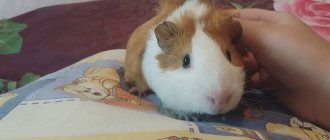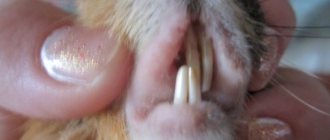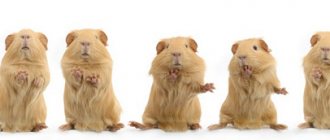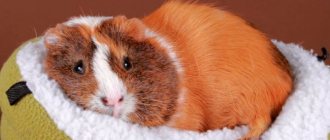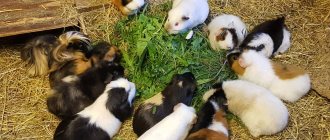Some behavior traits of guinea pigs can amaze even experienced breeders, while beginners can be completely shocked when trying to understand the strange behavior of the rodent.
When owners see a pig jumping or twitching for the first time, they often think that their animal is sick with something.
Popcorning is a behavioral feature of a rodent that causes an excited and playful state. This phenomenon occurs mainly in young animals under the age of one year, but it can also be found in older pigs. In this article you will learn everything about this unusual behavior of the animal.
Diseases
There are several reasons why your guinea pig will jump, jerk, or make other disturbing, erratic movements. Such reasons include the following:
- The appearance of skin itching when various parasites – lice eaters – appear on the animal’s fur. The animal often shakes itself in an attempt to get rid of them. To avoid this, it is necessary to constantly examine the appearance of your pet’s coat. You should examine your skin 1-2 times a week for peeling and redness. Their appearance is a sign of the onset of the disease. Over time, sores may form. If these symptoms occur, be sure to take the pig to a veterinary clinic or call a specialist at home. Only a qualified doctor can provide all the necessary assistance. He will prescribe the necessary medications to properly treat the rodent.
- Helminthiases are diseases caused by worms. The main signs of the disease are the appearance of inclusions in the animal's excrement and a sudden decrease in weight. To determine this, the owner must periodically check the animal’s feces for the presence of worms or their eggs.
- Diseases associated with the dental system. If the pig constantly jumps, shakes its head and also tries to chew through the bars, this indicates problems with its teeth. To help your pet avoid the formation of stones and plaque on the incisors, it should be shown to a veterinarian at the clinic. He will be able to tell you what the problem is and correct the abnormal growth of the roots of the teeth.
Why does my guinea pig jump and run around the cage? — Popcorning in guinea pigs
IMPORTANT: Don't be afraid if your pig suddenly starts eating popcorn.
When a guinea pig is absolutely happy and satisfied, it begins to run and shake its head - in this way the pig shares its joy with its owner. This phenomenon is called popcorning. The name was invented by the Americans when they noticed a surprising similarity between the cheerful jumps of a guinea pig and the process of making popcorn, when corn kernels burst in a frying pan and fly up. In other words, popcorning is a phenomenon in which a pig begins to behave like popcorn. At first this sight may seem strange, but over time you will get used to it and will watch your pet with a smile.
Reasons for crazy racing
Your guinea pig may suddenly start running around the cage due to the following reasons:
- Return to the cage. When you pick up a pig, it is stressful for him: a different environment, new smells, so when he returns to the cage, the pig feels comfortable and safe. These feelings give rise to the desire to run around tirelessly.
- Natural reaction. In most cases, such jumps are explained by a natural manifestation of joy. This is especially common in young pigs who are still full of strength and energy, as well as in groups.
IMPORTANT: Popcorning is contagious! The fun of one pig can easily make other pigs popcorn, even the adult generation.
- Diseases. If the previous reasons could cause joy and tenderness in the owner, then this reason should make him think and carefully study the pet’s behavior during the next races. Various exoparasites can disturb your pet, and dental problems are also possible.
In what cases is medical attention needed if a guinea pig is jumping and twitching?
Please note that guinea pigs are susceptible to a number of diseases with symptoms similar to popcorn. In this case, the pet’s jumping looks more like anxiety than fun: the pig seems to be trying to dodge something.
“Unhealthy” popcorn may indicate the following diseases:
- Skin parasites. These include blood-sucking parasites (ticks, fleas), as well as lice-eaters. They get on your pet's fur and cause itchy skin. When skin parasites appear, the guinea pig's jumps are accompanied by frequent scratching and biting of itself, it tries to rub itself on everything, and also shakes itself frequently to reduce the pain. The pig's fur loses its former shine and begins to fall out, forming bald patches on the body. In the early stages, redness and scaly skin begins to appear on the guinea pig's skin. Regular inspection of your pet's coat can be a preventative measure.
IMPORTANT: You can become infected with skin parasites not only by picking them up on the street while walking, but also at home (poor quality hay or bedding, poorly washed food).
- Worm infestations. This disease is accompanied by a sharp loss of weight and the appearance of inclusions in the pet’s feces. When cleaning the cage, always pay attention to your guinea pig's feces: if they are infested with intestinal parasites, they may contain eggs or adults. For treatment, you can use Shustrik paste, which can be purchased at any veterinary pharmacy.
- Dental diseases. If your pig is running around the cage and trying to chew through the bars, then most likely he has problems with his incisors. In this way, she tries to grind off the excess length of the incisors, which causes discomfort. Also, by its behavior, mumps can indicate improper growth of root teeth and the formation of tartar.
IMPORTANT: If you do not consult a doctor in time about a problem with your incisors, your pig will not be able to eat. The incisors can become so long that they simply block food from entering the mouth.
- Lack of movement. If the size of the cage does not allow the guinea pig to run around enough, it begins to run and jump in place. It is worth letting your pig out for a walk at least occasionally so that the lack of physical activity does not have a negative impact on its health.
Natural reaction
Sometimes the reason why your piggy is jumping can be due to its natural behavior. Most often this occurs in young individuals. The animals show their cheerful mood in this way, frolicking and rushing around the entire cage. Some rodents can rock the cage, making whistling sounds. If, in addition to the young pig, there are older individuals, then they begin to repeat after the young pig. The unusual behavior may last about 7-15 minutes, after which the pet either begins to drink and eat, or rests. This phenomenon among healthy pigs is called “popcorning.” The way they jump can be compared to the exploding kernels of corn when they are fried.
Popcorning
There is no need to look for reasons why a guinea pig jumps like mad around the cage due to diseases and disorders of the nervous system.
A guinea pig will only popcorn in a state of absolute pleasure, good mood and happiness.
Most often, popcorning in guinea pigs is observed at an early age, when the animal is full of energy and strength, however, an adult pig periodically jumps around the cage, making funny sounds and shaking its head. Often the females begin to jump around the cage after their frolicking cubs, and soon you will notice that the whole family of pigs is jumping merrily, squealing and kicking their hind legs. The name “popcorning” was invented by the Americans. They associated the unusual behavior of the happy animals with corn kernels bouncing in a frying pan while making their favorite popcorn.
Return to the cage
If your guinea pig is jumping around the cage, this may be a reaction to the animal returning to it after a walk. Familiar smells and surroundings bring the animal into joyful excitement. This reaction is normal, so the owner should not worry. It happens that a pet constantly jumps off his hands, and the owner approves of this. Under no circumstances should you allow your pig to behave this way. If she actively jumps from the owner's hands into the cage and back, she may injure herself on the bars or injure her paws. Therefore, it is better to wean the animal from a bad habit.
The pet must be held tightly when inserted into the house, but not released. The pig will have to be held until it calms down. Then the rodent must be quietly placed on the floor. Do not put pressure on the animal's back to avoid damaging the spine. If the pig still breaks out of your hands, you will have to repeat your actions a couple of times.
Features of behavior
By nature, guinea pigs are not aggressive creatures. Sometimes they sort things out in rare fights, establish a hierarchy, or simply defend their personal boundaries. However, clashes between animals are quite rare. The only exception is the Kui guinea pigs, who are quite militant not only towards each other, but also towards the whole world.
Most often, the animals are in a joyful and playful mood, willingly making contact with the owner, communicating with relatives.
But sometimes you can notice that the animal looks sleepy or snarls when trying to pet it, hides in a corner and sits with a ruff, and refuses the offered treat. This condition indicates the presence of diseases. The animal must be examined and, if necessary, shown to a veterinarian.
If the guinea pig squeals and twitches while the owner is petting the pet or scratching its tummy, then there is no need to worry. The animal is not sick. This is how he expresses his pleasure. Sometimes satisfied pigs can rumble or grumble, and even lick the owner's hands in response to pleasant actions. An interested animal grunts funny. They make similar sounds when communicating with each other.
Beginning breeders are often frightened by the strange behavior of animals: the pig runs around the cage, jumps, kicks, shakes its head and squeals. Some believe that the animal is sick, while others believe that something is bothering the pig or that it is scared.
This behavior is called popcorning and has a very positive explanation.
Other reasons
In some cases, a furry rodent twitches and jumps for completely different reasons. To determine them, the owner should remember events related to the pet that could please him. The animal can rejoice at the received treat or fresh tasty grass. If he has recently been walked outdoors, this may also cause unusual behavior.
It may have to do with the conditions in which the animal is kept. A rodent cannot warm up if it is in a cramped room. He needs more space to play. Due to the lack of active movements, the pet lies on its side and twitches. To change the situation, a caring owner must increase the space by adding toys, wheels and tunnels.
Where does this name come from?
It was already written above that a pig “fit” is very similar in appearance to exploding popcorn kernels in a hot frying pan.
It was this process that formed the basis for the name of the excited state of furry rodents. Although many amateurs compare this behavior with the jumping of an unbroken foal, which is more like the truth. In addition, in English, “pop” means “jumping”, and “corn” means intoxication (colloquial). It turns out that “popcorn” is literally translated as “drunken racing,” which, in principle, reflects the real picture of what happens to the pig at such moments.
conclusions
Guinea pigs jump because of joyful events or because of health problems. To determine the cause, it is necessary to monitor the behavior and condition of the pet. If you purchase a rodent from other people, you should find out whether the animal has been trained. Then the owner will not be concerned about the pet’s strange behavior.
Guinea pigs are rightfully considered one of the most unpretentious pets.
They ideal for keeping them at home: they are small in size, they don’t eat that much, they don’t run around the house and they can be placed in a small cage.
And their care is practically minimal. Guinea pigs are very friendly, they rarely bite, which means they are not dangerous even for the smallest members of the family. Pigs are very gentle and affectionate, calm, the main thing for them is delicious food and a clean home.
Although sometimes strange things happen to the cutest creatures in the world. Suddenly the pigs may start jumping and running around the cage, making a lot of noise. If you have recently brought such an animal into your home, then you will immediately wonder why such metamorphoses suddenly begin to occur with a calm animal.
Some owners panic, thinking that their four-legged friend has gone crazy, while others, on the contrary, rejoice, claiming that if their pets are active, then they are healthy.
What actually happens to guinea pigs and should you worry when they start jumping and running around the cage very actively, creating noise that is so unusual for them?
In reality, everything is not as scary as it seems. When your guinea pig starts running and jumping around the cage, this should not bother you, he is happy about something and there is nothing wrong with that, in this way the rodent shows others that he is happy.
Bad habits of guinea pigs
Keeping animals in cages without the opportunity to walk and communicate can lead to the development of many bad habits. A confined space causes severe stress in animals. Stress can be determined by the loss of appetite, and by the depressed state, and by the fact that the pig has begun to gnaw on the bars of the cage, feeders, drinking bowls, and even the house. Normally, pigs try to taste all surrounding objects - this is normal.
However, if the animal purposefully and concentratedly destroys objects, this indicates a state of stress.
If a pig is left alone for a long time and not given the opportunity to run and jump freely, this can lead to aggression and withdrawal. All guinea pigs are very social and sociable by nature, but if you don’t pay attention to them, they lose trust in their owner and can start biting, running away and avoiding human contact. Keeping him in a very cramped cage will also provoke the development of the habit of gnawing on the bars of the cage and all surrounding objects, and a reluctance to return to the cage after a walk, which will be shown in fights with the owner and sharp squeaking.
If the animal shows displeasure from the conditions of detention, it is worth changing the pig’s lifestyle, and not think about how to wean the pig from gnawing rods or biting.
- Buy a large cage (for one pig, the optimal cage size is 70 cm by 100 cm),
- Buy a couple for a bored animal (not necessarily an individual of the opposite sex, same-sex pigs get along well with each other),
- Provide a balanced and varied diet,
- Provide a daily opportunity to walk around the room sufficiently,
- Buy a few special toys,
- Pay more attention: scratch, stroke, talk, give treats.
If you don’t have enough free time, it is recommended to purchase a much larger cage or even a two-level one. Divide the feeding and playing areas inside, as well as an area for relaxation and sleeping. Install several mazes, hang smart toys with food inside and several comfortable hammocks. It is important to hang the hammocks as comfortably as possible for the animal, since its legs are very fragile and are not intended for high-altitude jumps. A fall from a high hammock can also result in injury. In such a cage the animal will always find something to do.
Diseases
Sometimes endoparasites or lice eaters can get on an animal's fur. They cause itchy skin. Therefore, the guinea pig itches and jumps, and also makes other restless, chaotic movements. In addition, the animal often shakes itself.
It is important to regularly check the condition of your pet's coat, especially for long-haired breeds. You need to examine your skin at least once a week. The onset of the disease may be accompanied by redness and peeling. Later wounds appear. If such symptoms are detected, you should consult a specialist. Help can be provided by a veterinarian who will select the necessary medications and prescribe the necessary treatment.
Contacting a veterinarian
However, sometimes an animal’s unusual behavior can also mean health problems. If the pet jumps around the cage, lies around, itches itself on everything, and the fur looks dull, begins to fall out and bald patches appear - this indicates the appearance of skin parasites. An animal can become infected with them not only by walking down the street. Often flea or tick larvae get to the animal along with low-quality hay or bedding, as well as poorly washed food. If your pig shows anxiety and loses his appetite, you should consult a doctor. Analysis of the skin scraping will determine both the type of parasite and the degree of infection.
Basic moments
Crazy jumps around the cage are not a cause for concern, but a reason for joy. The galloping animal is not sick, but happy and splashes out its accumulated energy.
Popcorning is crazy jumps and somersaults
Strange actions performed by a pet are called popcorning. The choice of name was due to the amazing similarity of rodents to corn kernels bouncing in the microwave while popcorn is being made.
Funny behavior is common to all ages, but is more common in young individuals.
Pig shows last about 5 minutes and include:
- jumping and turning over in the air;
- dancing using the fifth point;
- squeals, squeaks and other crazy sounds of delight;
- falls and febrile convulsions;
- cutting circles at the incredible speed of a racing car.
If the pig runs around like crazy and successfully involves other cage inhabitants in its madness, then release the animals to freedom. After expanding the territory, the rodents will quickly calm down and fall into deep sleep, replenishing the energy expended.
After a burst of energy comes a sound sleep
Natural reaction
In most cases, the answer to the question “why is a pig jumping” is that this is normal behavior for piglets. As a rule, young animals are prone to such actions. They become happy, they run around the cage and make noise. They can even rock the cage. Some pigs whistle at this.
If there are several individuals in the cage, then representatives of the older generation can also join in the fun of the piglet. After this warm-up, which can last 5-10 minutes, the pigs rest, eat and drink water.
The reason is parasites
Pig scabies
The scabies mite, which settles in the deep layers of the skin, causes the skin to itch unbearably.
The guinea pig begins to itch so intensely that this leads to hair loss - the animal literally goes bald - and the formation of wounds and ulcers at the site of the lesion.
This poses a double danger: pathogens of more serious diseases can penetrate through such a wound.
How does scabies mite infection occur? It may be brought into a cage with poorly washed food in the form of hay or grass. The larvae of the parasite can be transmitted by both infected animals and people, for whom it is, in principle, not dangerous. The scabies mite leads to hair loss, sores and pustules form.
Places of insect parasitism are most often noted on:
To determine the presence of a tick, a deep skin scraping is done. If the result is positive, the veterinarian will determine the method of treatment. This course can be quite long - up to a month.
As a rule, it consists of three “approaches” of 10 days each in the form of subcutaneous injections of Ivermectin. This is explained by the fact that the injections are not able to destroy the eggs laid by females and are “forced to wait” for the appearance of new offspring.
The administration of Otodectin, Novomek, and Ivermec is also practiced. The drugs can be used to treat infected areas two to three times a day. Moreover, animals that were in contact with a sick individual also need to be treated.
In addition, the most thorough sanitary treatment of the cell with lime sulphide, an aqueous solution of which is prepared at a rate of 1:40, is also necessary. Before returning a sick animal to the living space, the cage is wiped dry.
Similar treatment should be carried out in case of infection with other parasites.
Why does a guinea pig sneeze?
Who eats hairs?
Skin parasites called lice eaters are similar to regular lice. Their size - almost one and a half millimeters - allows you to see the insect on the skin, especially with a magnifying glass.
This type of parasite eats blood, skin particles and hair follicles of the animal. Due to the fact that they gnaw the hair at the base, baldness begins on the diseased back. So the first symptoms of lice-eater infestation are as follows: Lice-eaters are similar to ordinary lice.
- hair loss;
- severe itching (and not always);
- Dandruff is often observed.
A pig can become infected with the “help” of hay, sawdust, or loosely packaged food purchased at a pet store, where there could be decorative pets infected with lice.
Parasites infect the back, croup and perineum of a pet.
Treatment is carried out, as a rule, with sprays intended for treating cats and rodents for the same purpose: Acaromectin, Bars-, Bolfo-, Celandine-spray. Some breeders recommend using “human” drugs for head lice. Stronghold or Advocate drops for kittens are considered effective, with a dosage strictly in accordance with the weight of the pet.
By the way, many experts do not recommend using sprays to treat affected areas, since the animal, while washing, can lick them off and become poisoned. It is better to use drops, applying them topically - especially on the affected areas.
Pediculosis in a pet
Most often, lice settle on the head and ears. Severe itching is a common symptom when infected with lice. In addition, peeling of the skin and redness of its areas are observed. The guinea pig squeaks, jumps around the cage and itches.
Often, lice appear at the same time as a tick, transmitted through contact with an infected animal or through contaminated bedding.
These parasites are visible to the naked eye. They choose the head and ears of a rodent as their habitat.
Treatment is also carried out by administering Ivermectin. If the infestation has not yet started, then lice can be dealt with by carefully combing the fur with a thick comb.
Why are you jumping here, flea?
The most common parasites in pigs are fleas. Their bites also cause:
- itching;
- skin lesions;
- partial baldness.
Anemia may occur with multiple bites!
If treatment is not treated promptly, the “attack” of parasites deprives the pet of appetite and sleep, it is in a state of constant stress, which can lead to exhaustion and even death.
To remove these parasites from pets, medications containing pyrethrin are used.
Worms
If, in addition to the fact that the pig is constantly itching, she also loses her appetite, but her thirst increases, and apathy is observed, we can assume that she has worms.
If this problem is not identified in time and not dealt with, the animal will begin to wither before our eyes, serious digestive problems will arise, which can result in intestinal obstruction.
For every type of rodent, anthelmintic drugs such as “Shustrik”, Dirofen pastes or Prazicide suspensions are produced.
Necessary for care
Like any other pet, a guinea pig requires a wide variety of grooming accessories. These include:
- cage or aquarium;
- feeder;
- sippy cup;
- house;
- filler;
- mineral stone;
- toys;
- carrying;
- hygiene products;
- brush-comb and nail clipper.
Cage or aquarium
Keeping a guinea pig is allowed both in an aquarium and in a cage. The main condition is size: the dwelling must be at least 50 cm in length and 30 cm in height so that the animal can move comfortably. If you have decided on a cage, then it is best to take a closer look at the options that have a plastic bottom. Plastic is quite easy to care for, it is easy to wash, dry, etc. A wooden base is not suitable due to the fact that these animals drink a lot of liquid per day, and therefore excrete a large amount of urine. The wood will simply become unusable in a very short time. You can purchase an aquarium in the above sizes. It, like a cage with a plastic bottom, is easy to wash and clean. But you should be careful, since glass is a very fragile material and when moving it, for example, to another room, you should follow safety rules (the pet should not be in the aquarium, it should be transferred to a carrier).
cell
Feeder
The feeder should be heavy enough so that the guinea pig cannot knock it over. An excellent option would be bowls made of ceramics, stainless steel, etc. It is also recommended to buy 2-3 containers. For example, one will be used for vegetables or fruits, and the second for dry food.
Sippy cup
A vertical ball sippy cup is perfect for a guinea pig. It is usually made of plastic with a metal tip. In such a drinking bowl there is no need to change the water daily, but this is done about 2-3 times a week.
House
Be sure to install a small house in the cage or aquarium. Your pet will sleep in it, relax, or simply retire when he wants to be alone. Most often, such houses are made of wood with a round “door” cut out in the middle. The most optimal size is 25 cm in length and 15 cm in height. This space is enough for the animal to hide and at the same time feel comfortable.
house
Filler
When arranging the cage, do not forget about the bedding. It will create comfort in the cage, prevent the animal from freezing and, to some extent, maintain cleanliness. You can use sawdust or ground corn cobs as a filler. Under no circumstances put cotton wool, newspaper, paper, etc. in the cage as bedding, as this is not safe for your pet’s health.
Mineral stone
To maintain dental health and calcium levels in your guinea pig's body, mineral stone is essential. After all, it serves not only as a vitamin complex, but also perfectly helps the animal grind its teeth. This stone is sold in a pet store, and its price is quite affordable.
stone
Toys
Guinea pigs are somewhat similar in behavior to decorative rabbits. They love to play. Therefore, be sure to buy some interesting and funny toy for your pet, for example, a tunnel, a hammock, a mirror, a rolling wheel, etc. The game will not only bring joy and pleasure to the animal, but will also strengthen muscles, and will also be an excellent preventive measure against obesity.
Carrying
If your plans did not include traveling together or any trips with your guinea pig, then you will still need a carrier. Transporting an animal in your arms, in a box or blanket is strictly prohibited. For example, you need to visit a veterinarian or transport the animal to another house or apartment; in such life situations, a carrier will definitely help you out. The pig will feel safe and the transportation process will go smoothly.
Hygiene products
Guinea pigs are considered clean animals, but sometimes they are still allowed to be bathed. For such cases, it is necessary to use special hygiene products that can be purchased at a pet store. The most popular of them:
- "Biogance" - bio-perfume;
- "Veda" - wheat shampoo.
Brush-comb and nail clipper
Caring for your guinea pig's coat and claws is extremely important. To do this, you need to purchase a special comb with soft bristles (combing is done daily), as well as a nail clipper for trimming the claws (the procedure is performed as they lengthen).
Return to the cage
Another option when a guinea pig jumps is to return the animal back to the cage. The rodent enjoys familiar surroundings and smells; this is also a natural reaction of the pig and there is no need to worry in this case.
Sometimes it happens that a guinea pig jumps out of the owner's arms, and the owner allows and even encourages this behavior of the animal.
Remember! Your pet may fall and injure its paws if it actively jumps from your hands. Therefore, he should be weaned from such behavior in the future.
To do this, holding the animal tightly, you need to stick your hands inside the home and hold them a few centimeters from the floor. The pig needs to be held until it calms down. Then carefully place the pet on the floor, but do not let go until the rodent gives up its attempts to escape from you. You need to hold it carefully so as not to damage the back. This lesson may need to be repeated several times.
Expert opinion
Experts say that guinea pigs periodically eat their droppings to restore their intestinal microflora, just like other herbivores. This phenomenon is called coprophagy, it is considered completely normal and physiologically necessary for life, so there is no need to prohibit animals from doing this.
Zoologists claim that the microflora of the guinea pig’s cecum synthesizes substances necessary for the body:
- enzymes; B vitamins; amino acids; vitamins K.
At the first meal, these microelements are not absorbed in the body, so animals eat their feces and reabsorb the substances they contain.
Initially, rodents eat grass, hay and food, which contain a large amount of fiber, which does not have time to be digested immediately. As food particles pass through the gastrointestinal tract, they are influenced by bacteria, which break down food into amino acids. After the waste products have come out, the animal eats them, and all the substances are normally absorbed in the body for the second time. Thus, the pet's intestines will function normally.
conclusions
Why do guinea pigs jump? Often this happens because they are happy with everything and simply enjoy life. This is mainly typical for young people, but older pigs can also run and jump, although not very high. In some cases, the owners themselves teach the animals various tricks, including jumping and running in circles. Perhaps you got an already trained pet.
Did you like the article? Share with friends: [supsystic-social-sharing >
- Related Posts
- What to feed your guinea pig
- Guinea pig's hair is falling out
- Diagnosis, symptoms and treatment of worms in guinea pigs
Why does my guinea pig jump around the cage and twitch?
Guinea pigs usually behave calmly and evenly, but sometimes their behavior deviates from the usual. They may begin to behave inappropriately and in a frightening manner: jumping, continuously running around the cage, twitching, etc. There is no single answer to why a pet loses self-control and begins to behave so strangely. Such manifestations can be caused by various reasons.
Not enough vitamins?
Don't forget to feed your pet with vitamins. The animal itches, has a rash on its skin, and hair falls out. The pet is apathetic and inactive. Sometimes he gets constipated.
If a concerned owner takes a sick pet to the veterinarian, and the tests done do not confirm the presence of any parasites, a diagnosis can be made: vitamin deficiency. Most often it manifests itself in the winter-spring off-season and is associated with a lack of succulent feed containing vitamin C.
What to do in this case? Treatment is extremely simple: you need to increase the portions of such feed. You can also add ascorbic acid to drinking water - no more than 1 mg per liter of liquid.
Experts highly recommend placing a bunch of fresh parsley in the cage, rich in this vitamin and loved by guinea pigs.
It is also necessary to provide the sick rodent with a quiet and warm place so that the weakened body does not catch a cold, which can lead to pneumonia.
Nutrition composition
A very important component of a healthy life for a guinea pig is nutrition. This animal is forbidden to starve, not because the body needs nutrients, but because these animals lack peristalsis
This feature is that processed food can leave the intestines only if new food arrives, in other words, a new piece of food pushes through the already processed one.
But you should be very attentive and careful, you cannot leave them hungry, but it is also prohibited to overfeed them, because this can lead to obesity, which is also dangerous for the animal.
Therefore, you need to approach the organization of your diet as responsibly as possible, adhering to the daily nutrition standards:
- 60% is feed.
- 20% - vegetables and fruits.
- 20% - hay, branches of fruit trees, crackers.
We must not forget about vitamins and minerals. The animal must always have clean water.
How does it manifest?
Popcorn attacks can cause fear and panic in an inexperienced owner. At these moments the animals:
- quickly run in circles;
- jump and twitch while jumping;
- they squeak and squeal loudly;
- periodically fall;
- shaking and turning their heads.
The process lasts 5–7 minutes, but there are also protracted cases. There is no need to be afraid of such scenes. This is not a sign of rabies or mental problems, but a natural manifestation of increased excitability of the animal. In such cases, the pig is released from the cage so that it splashes out energy and does not get injured in a cramped space. After the “fun” the animal calms down and falls asleep. Young individuals are susceptible to attacks more often than adults.
What can it be confused with?
The pet's body movements during popcorning can be confused with the manifestation of fear, which was caused by:
- Loud noise;
- sudden movements;
- sudden touch by the owner;
- cleaning the cage (some animals don’t like this).
Popcorning is a relatively safe process that stops on its own and does not subsequently affect the pet’s behavior. And frightened, chaotic movements require immediate elimination of the cause that caused them, because at this moment the animal is experiencing severe stress.
In addition to fear, your pet's jumping can be caused by:
- Blood-sucking parasites - ticks, fleas. The animal will itch and its fur will fall out. Infection usually occurs through hay.
- Worms. Signs of this disease are a decrease in the pet’s weight, the presence of parasites or their eggs in the feces.
- Dental disease. If your pig is desperately trying to chew through the bars of the cage and is constantly running around, this may indicate a dental problem.
The energetic jumping and squeaking caused by popcorning is a normal manifestation of your pet's joy and high spirits. To rule out the possibility of illness, you should monitor your mumps during an attack. If there are no dangerous symptoms, then there is no reason to worry.
Sometimes guinea pigs can surprise even experienced breeders, let alone beginners who are stunned, trying to figure out why their pet is twitching and shaking its head. When seeing such a sight for the first time, pig owners are horrified and begin to suspect various terrible diseases. What could be the reasons for their instant activity?
Origin
Skinny is a relatively new breed. Naturally, animals with such data cannot live in the wild. In 1978, within the walls of the Armand Frapper Institute, in Montreal, Canada, the fact of a new mutation of a hairless pig, which appeared naturally, was officially recorded and described. This is where the history of the breed could have ended if the phenomenon had not repeated itself in 1984. The bald white pig gave scientists the idea of breeding radically hairless pigs.
As a result, the first female was given the nickname Skinny. Later this nickname grew into the official name of the breed. Translated as skin and bones.
The first hairless animals bred were used exclusively for dermatological research. Their immune system is similar to humans.
Scientists worked hard on the breed, increasing the animal's endurance. To strengthen immunity at the genetic level, she was crossed with selfies. As a result, the animals left the walls of the laboratory and ended up in the homes of guinea pig lovers with a fairly strong immune system. However, even today, Canadian breeders recommend updating the skinny's blood every two generations to maintain the animal's immune system.
Negative signals
A frightened guinea pig will say a dull “Urrrr”, similar to a vibrating alert on a phone, and will tremble slightly. But she indicates irritation with a short sharp squeal - for example, when you carelessly touched her. If the pig is angry, it squeals for a longer time, while clicking its teeth, as if warning: “I’m not in the mood for jokes!”
One of the most impressive sounds a pig makes can be heard at night. This is a very sharp intermittent squeak, similar to the cry of a bird caught in a snare. At the same time, the pig freezes in place, her gaze glazes over. An inexperienced owner may be afraid for his pet. This sound is used by pigs to call their relatives. Little pig babies can express their fear this way.
Since guinea pigs are herd animals, they find it sad to live alone. If your pig makes this noise frequently, try petting your pig more often or give him a buddy in his cage.
If the pig is hungry, you won't miss it. She will stand up and scream shrilly throughout the apartment: “Wee-wee-wee!”, moving her ears. It’s amazing how loud such a small animal can be! Guinea pigs study their owners. They usually remember sounds, such as the sound of a knife hitting a cutting board when preparing a salad or the rustle of a bag from which cabbage is taken out. Subsequently, upon hearing these sounds, the pigs whistle invitingly. They also have a well-developed sense of smell. So you’re unlikely to be able to quietly snack on a cucumber; the alarm will immediately go off!
Popcorning in guinea pigs is a condition of an animal in which its behavior is, at first glance, inappropriate: chaotic running, jumping, convulsions. This looks unusual, but should not cause panic. This playful state is natural and safe. However, its signs are similar to those of some diseases, so it is important to correctly interpret your pet’s behavior.
Nutrition
In order for your pet to feel good and not get sick, you should feed it properly. Guinea pigs are unpretentious eaters. They need to be given food in the morning and evening. The pet's diet mainly consists of dry food:
- hay;
- clover, dandelions, plantain, nettle;
- straw;
- cereals (millet, flax seeds, oats and sunflower seeds);
- cherry, currant, raspberry, gooseberry, pear and apple leaves;
- birch, maple, oak bark and their leaves;
- legumes (beans, lentils, peas).
You can use food purchased at pet stores. Just don’t change them often to avoid developing gastrointestinal upset. The cage should also contain mineral salt wheels and chalk so that the guinea pig receives all the substances necessary for growth and a full life.
Wet food should be included in the diet in minimal quantities - approximately 7 grams per kilogram of the pig's weight. These foods include carrots, apples, pears, beets, bell peppers, lettuce, zucchini, cabbage, pumpkin, and turnips. In the summer, you can pamper your pet with carrot and beet tops, corn leaves, and pea branches.
It is forbidden to feed your guinea pig potatoes, various cereals, cottage cheese, watermelon, sweets, and salty foods. It is also prohibited to give winter cucumbers, plums, spinach, eggs, fish, meat, green onions, radishes, mushrooms and bread. Before treating your pet with herbs and vegetables, they must be thoroughly washed and dried.
Since these rodents love to drink, you need to make sure that the water in the sippy cup is always fresh. It needs to be changed every day. For such purposes, only purified or filtered water is suitable. You should absolutely not use tap or boiled water.

